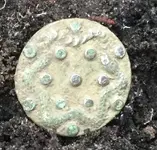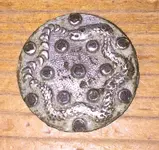Ron (CA)
Hero Member
- Joined
- Feb 1, 2005
- Messages
- 555
- Reaction score
- 1,517
- Golden Thread
- 6
- Location
- Mechanicsville VA
- 🥇 Banner finds
- 6
- Detector(s) used
- CTX 3030 , Deus 1 & 2,
WOW-- I am still excited over this button.
Just got back from my annual Charleston SC trip and I was very fortunate to get over this fantastic button. I got two rare rev war buttons this trip but this one by far out shines anything else that i found on this trip. I will post the other one i get it cleaned a bit more. But it is a SC 2 rev war button.
We got on a plantation site and a buddy had walked the woods and found an old home site. He called us in but it was very overgrown with small pines, briars and almost impossible to hunt most of this area. Most everyone else decided to go check out another rev war camp but 3 of us decided to stay back and crawl through the thicket. My first targets were a few flat buttons and then I popped out a copper coin. King George 1773 I think. Need to clean it a bit mreo.
I was working my way through and under some small pines when I got a great signal. I dug it out and it was covered with a thick layer and could not see it. I gave it a wipe and then I saw the "dots" and squiggly line around the outer edge. At first thought it was a flower button. But something looked very familiar but I didn't want to get too excited until I could confirm. I kept looking for the snakes head and then it finally showed through the thick layer of crud. I yelled out to my buddy adn gave a brief description "snake around some dots" and he got pretty excited as he knew right away what I had dig. He worked his way through the thicket over to where I was and he confirmed what I was hoping!! High fives and and a little victory dance!!
A RARE Rattlesnake and Eggs Revolutionary War button. You can see the progression of cleaning. This thing is still loaded with the silver plating.
WOW-- I am very excited over this button!! One of my BEST for sure!!
here is some info i lifted off the internet about a similar button.
This button style can be found in Don Troiani and James L. Kochan's Insignia of Independence , page 259, AUS.c. And it states, "Rattlesnake among thirteen eggs. Struck sheet copper, gilded, with eye shank. Found near Charleston, SC. 24mm" The button depicts 13 rattlesnake eggs with the Rattlesnake encircling them in a star formation as if it is protecting them. It should be noted that there are also 13 rattles (or buttons as they're called) on the snakes tail.
These types of Rattlesnake buttons are still commonly believed to be of French import and manufacture.
Even before the Revolution, the rattlesnake was a popular symbol of the American cause. Rattlesnakes are native to North America; they don’t attack unless provoked (a give a warning before attacking even then); and although an individual rattle might not be heard, acting together, the rattles can be heard by all. In 1754 Benjamin Franklin’s Pennsylvania Gazette printed the Join, or Die Flag with the segmented rattlesnake. It was printed to remind delegates at the Albany Congress of the importance of unity among the colonies in light of the impending war with France (French & Indian War). By 1774 the snake was usually shown whole and the motto had become, United Now Alive and Free Firm on this Basis Liberty Shall Stand and Thus Supported Ever Bless Our Land Till Time Becomes Eternity." One example of the united snake was the Culpepper Flag, which was probably based on a design that had been created to protest the Stamp Act called “Rebellious Stripes.” It was one of the first flags used by the American Navy. This flag (or a variation of it) was flown on American ships throughout the Revolution. The Gadsden Flag is a variation of the Don’t Tread on Me Flag. Its field was bright yellow. Designed by Colonel Christopher Gadsden of South Carolina, it was first used in February 1776 by Commander Esek Hopkins, Commander in Chief of the new Continental fleet. The snake motif was also commonly used on the mastheads of Colonial newspapers.This is an important American treasure and a relic that reminds us of our struggle for Freedom and Liberty and the sacrifice these early Americans made.
Just got back from my annual Charleston SC trip and I was very fortunate to get over this fantastic button. I got two rare rev war buttons this trip but this one by far out shines anything else that i found on this trip. I will post the other one i get it cleaned a bit more. But it is a SC 2 rev war button.
We got on a plantation site and a buddy had walked the woods and found an old home site. He called us in but it was very overgrown with small pines, briars and almost impossible to hunt most of this area. Most everyone else decided to go check out another rev war camp but 3 of us decided to stay back and crawl through the thicket. My first targets were a few flat buttons and then I popped out a copper coin. King George 1773 I think. Need to clean it a bit mreo.
I was working my way through and under some small pines when I got a great signal. I dug it out and it was covered with a thick layer and could not see it. I gave it a wipe and then I saw the "dots" and squiggly line around the outer edge. At first thought it was a flower button. But something looked very familiar but I didn't want to get too excited until I could confirm. I kept looking for the snakes head and then it finally showed through the thick layer of crud. I yelled out to my buddy adn gave a brief description "snake around some dots" and he got pretty excited as he knew right away what I had dig. He worked his way through the thicket over to where I was and he confirmed what I was hoping!! High fives and and a little victory dance!!
A RARE Rattlesnake and Eggs Revolutionary War button. You can see the progression of cleaning. This thing is still loaded with the silver plating.
WOW-- I am very excited over this button!! One of my BEST for sure!!
here is some info i lifted off the internet about a similar button.
This button style can be found in Don Troiani and James L. Kochan's Insignia of Independence , page 259, AUS.c. And it states, "Rattlesnake among thirteen eggs. Struck sheet copper, gilded, with eye shank. Found near Charleston, SC. 24mm" The button depicts 13 rattlesnake eggs with the Rattlesnake encircling them in a star formation as if it is protecting them. It should be noted that there are also 13 rattles (or buttons as they're called) on the snakes tail.
These types of Rattlesnake buttons are still commonly believed to be of French import and manufacture.
Even before the Revolution, the rattlesnake was a popular symbol of the American cause. Rattlesnakes are native to North America; they don’t attack unless provoked (a give a warning before attacking even then); and although an individual rattle might not be heard, acting together, the rattles can be heard by all. In 1754 Benjamin Franklin’s Pennsylvania Gazette printed the Join, or Die Flag with the segmented rattlesnake. It was printed to remind delegates at the Albany Congress of the importance of unity among the colonies in light of the impending war with France (French & Indian War). By 1774 the snake was usually shown whole and the motto had become, United Now Alive and Free Firm on this Basis Liberty Shall Stand and Thus Supported Ever Bless Our Land Till Time Becomes Eternity." One example of the united snake was the Culpepper Flag, which was probably based on a design that had been created to protest the Stamp Act called “Rebellious Stripes.” It was one of the first flags used by the American Navy. This flag (or a variation of it) was flown on American ships throughout the Revolution. The Gadsden Flag is a variation of the Don’t Tread on Me Flag. Its field was bright yellow. Designed by Colonel Christopher Gadsden of South Carolina, it was first used in February 1776 by Commander Esek Hopkins, Commander in Chief of the new Continental fleet. The snake motif was also commonly used on the mastheads of Colonial newspapers.This is an important American treasure and a relic that reminds us of our struggle for Freedom and Liberty and the sacrifice these early Americans made.
Attachments
Upvote
69








 BANNER find no doubt - now let's see the pewter
BANNER find no doubt - now let's see the pewter
